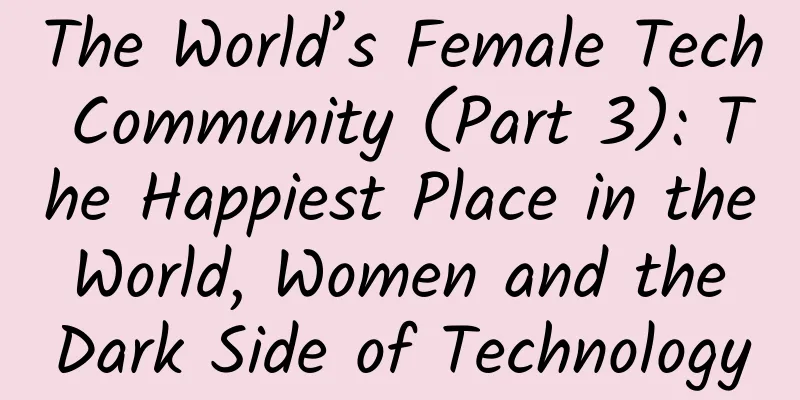The World’s Female Tech Community (Part 3): The Happiest Place in the World, Women and the Dark Side of Technology

|
This series has traveled through Africa and South Asia. Under the barren social soil, the imbalance of digital technology is very prominent, and the relationship between technology and women seems to be able to only reflect each other in the dim light like fireflies. But the situation of women around the world is also very different. For example, Scandinavia, which is known as the happiest place to live in the world, is in a well-developed environment for both technology and women, which seems to be a "utopia". ·Technological innovation and prosperity. The Nordic region is a global leader in technological innovation, with world-renowned brands such as Ericsson, Volvo, Nokia, Skype, Opera, and Angry Birds. A 2017 report found that four of the five European companies most likely to reach a valuation of $50 billion are Nordic companies, namely music streaming service Spotify, electronic invoice company Klarna, and game companies Supercell and Unity. It is worth mentioning that the population of the Nordic region is only 27 million, so its per capita GDP easily crushes countries such as the United States, Germany, Britain, and Japan. ·Advanced educational philosophy. The innovative atmosphere of Nordic society can be seen from children's education. Children are trained to be adventurous and bold thinkers from an early age, and universities also encourage students to start their own businesses. This educational method that continuously motivates people's productivity has made Nordic education widely praised worldwide, and has also exported a large number of highly skilled and well-educated scientific and innovative labor to the Nordic countries. Stina Ehrensvärd, CEO of cybersecurity company Yubico, believes that the independence that Swedish children are encouraged to have at every educational stage of their lives is the driving force behind the country's innovation: "I noticed that my Swedish team is actually more challenging than my American team because they often ask questions." (Stina Ehrensvard, CEO of Yubico) Social equality and inclusion. Another characteristic of the Nordic region is the extremely high level of social equality, which is reflected in the relationship between people. Because of equal pay for equal work and fair career development opportunities, people can easily regard colleagues as allies rather than opponents. "I'll roll you to death" rarely happens in Northern Europe. If a teacher wants a week off, other teachers will unite to take over his class. In addition, the gender gap in Northern Europe is also the smallest among OECD member countries. The five Nordic countries are among the top 144 countries in the Global Gender Gap Report. Among them, the prime ministers of Denmark, Finland, Iceland and Norway are all women. Women account for 47% of the Swedish parliament. This is also the region with the smallest gender gap in the labor market in the world. In such a high happiness region, can women fully embrace technology and show their creativity? In other words, is Northern Europe the ultimate template for women and technology? Unfortunately, the answer is no. It stands to reason that with equal societies and advanced technology, the number of Nordic women working in technology should be high. But in reality, taking Sweden as an example, the proportion of women working in technology is extremely small. In the IT and computer fields, less than one-fifth of employees are women, and in the engineering and technology fields, only one-quarter of engineers are women. This also makes us curious about what the relationship between women and technology is like in a place that is known as the happiest in the world. Today, let’s go to the dark side of the moon in Utopia. What is the per capita innovative technology like? Today, people around the world may not have heard of the Nordic countries, but they have certainly used Nordic technology. The world's first mobile cellular phone originated in the Nordic countries. To this day, the Nordic countries are still a banner of global technological innovation, and their outstanding achievements include the following areas. 1. Biotechnology. The field of life sciences is a traditional strength of the Nordics. In 2005, biotechnology and medical technology accounted for nearly one-third of all venture capital investments in Sweden. In addition, the government has invested a lot of public funds to support the development of biotechnology. Although Denmark is only the size of Silicon Valley, it has eight universities, six university hospitals and more than 140 biotechnology companies. Researchers also lead the world in the number of biotechnology patents per capita. In EIT Health Scandinavia, one of the world's largest life science programs, 14 of the 89 co-developed start-ups are from the Nordic region, and 3 of them have been selected for the COVID-19 Headstart key program. During the COVID-19 pandemic, the Norwegian University of Science and Technology (NTNU) developed a new Covid-19 test method that has been used internationally. (Oslo, Norway) 2.ICT information and communication technology. Nordic countries are leading the digitalization process of the whole Europe. News such as "Can only read books because of lack of 4G" and "Credit cards are mature and resist mobile payments" rarely appear in Northern Europe. The digital infrastructure here is significantly higher than the EU average, so digital services are also very developed. Almost all Nordic banks have begun to invest in new IT systems and digital business models, and various online banking services are being used more and more. As of 2020, Denmark and Norway have the highest mobile Internet penetration rates in Europe, with about 90% of the population using mobile devices to browse the Internet, higher than the EU average of 70%. More than 80% of the Swedish population uses mobile electronic ID cards. From 0G to 5G, Northern Europe is the core area of mobile communication innovation and has always been ambitious about the next stage of digital development. As early as 1876, 30-year-old Lars Magnus Ericsson opened a telephone equipment repair shop in Stockholm. Since then, Ericsson, Nokia and others have led mankind into the mobile communication era. In the 5G stage, Northern Europe has also made many key contributions to innovations such as new standard designation, IoT solutions, and operator networks. 3. Green technology. The Scandinavian Peninsula, which is close to the Arctic Circle, is in urgent need of new energy and green technology. In recent years, Nordic countries have been actively working to change their dependence on oil resources. Cloud vendors such as Microsoft and Google have also set up data centers in Northern Europe to explore carbon-free computing models. Microsoft Sweden General Manager Hélène Barnekow said that Microsoft's Swedish data center is one of the most sustainably designed and operated data centers in the world, and it is the first region for Microsoft to use Preem Evolution Diesel Plus to run backup generators, a fuel that contains at least 50% renewable raw materials. Norwegian Minister of Digitalization Linda Hofstad Helleland predicts that the use of artificial intelligence and big data could double Norway's GDP growth by 2030, and more data centers will be needed to achieve this goal. As a result, the Norwegian government has also released a sustainable data center strategy, investing $300 million (2.7 billion Norwegian kroner) in new data centers during 2019 and 2020. (The woman on the right is Linda Hofstad Helleland, Norway’s Minister of Digitalization) 4. Network services. Solid digital infrastructure and a social atmosphere that encourages entrepreneurship and innovation have paved the way for mobile Internet and given birth to a large number of start-ups in Northern Europe. For example, in the field of online games, Angry Birds, created by Finnish game studio Rovio, is one of the most famous mobile games in the world. In addition, online casinos in Sweden and Finland (which are legal locally) are also very popular, with well-known game developers such as Digital Illusions. Spotify, a music streaming service founded in Stockholm, Sweden in 2008, is one of the largest brands in the field, covering 61 countries and regions around the world. Others such as online finance, credit payment, and e-commerce are very active in Northern Europe. (Nordic E-Commerce 2018, by PostNord) You may have noticed that we did not deliberately mention what women can do in the Nordic technology map. This is because the egalitarian thought that is deeply rooted in the Nordic DNA is the first region to legislate to remove obstacles to women's careers and set gender quotas; in addition, Nordic countries are not as extreme as most Western countries in advocating free markets, and technological development is largely supported by the state. The Finnish Ministry of Commerce and the Norwegian official agency "Innovation Norway" are all sources of funding for local start-ups... All these have determined that Nordic women have a very high degree of digital literacy, relatively high levels of education, and a balanced ratio of male and female employment. Therefore, it is normal and inevitable for women to appear in the Nordic technology field. In addition to the female leaders of the digital department mentioned above, the director of digital development at Isavia, one of Iceland’s largest companies, is also a woman. There are investment institutions dedicated to supporting female entrepreneurs, such as Nordic Female Founders. Well, Nordic women win, and this article ends... Just kidding. In fact, although Nordic technology is world-leading and the environment for women is very friendly, there is still a famous paradox among Nordic women - the Gender-Equality Paradoxin. Is the gender equality paradox the ultimate curse for women in technology? A 2017 research article in Science magazine, “The Gender-Equality Paradoxin Science, Technology, Engineering, and Math Education,” suggested that the greater the level of gender equality in a country, the less likely women are to choose math and science careers. This seemingly counterintuitive phenomenon actually exists. Stoet and David Geary of the University of Missouri found that in most countries, girls tend to be better at math and science. But in countries with high gender equality, such as Norway and Finland, women make up less than 25% of college graduates in STEM fields. In contrast, in countries with low gender equality, such as Algeria and Turkey, women make up a much higher share of STEM degree holders. (Trends in the percentage of women studying STEM) Data from other institutions also support this conclusion. According to Samordna Opptak (NRK 2019), the proportion of women receiving IT education in Sweden increased slightly from 20% in 2008 to 23.3% in 2014, and the proportion of women studying information technology in Denmark has stagnated at around 27% since 2008. The gender gap in the technology field in the Nordic region is almost the largest among developed countries. On the contrary, in the Middle East, where gender inequality is extremely high, the United Arab Emirates is one of the countries with the largest number of female STEM graduates. Researchers believe that this may be because Nordic countries are richer and more inclusive, and women have the economic freedom to pursue their natural interests. At this time, they will turn more to the humanities, and women with children are more willing to choose low-paid but flexible jobs because of family-friendly time and welfare guarantees. In areas with relatively low equality, relatively high-paying STEM occupations are more attractive to women due to fewer economic opportunities, attracting them to actively choose. Since not choosing STEM jobs is a free choice for Nordic women, why are the country and society in such a hurry? On the one hand, the Nordic technology industry is really, really, really short of people. Denmark alone will face a shortage of around 19,000 ICT specialists by 2030. The situation in Sweden appears even more alarming, with the country facing a shortfall of 70,000 people with IT or digital-related skills by 2022. According to IKT Norges’ 2017 annual competence survey, 38% of Norwegian companies said they had unfilled IT positions. Young women who choose to study STEM subjects and pursue careers in science and technology are less likely than young men, and they cannot keep up with the pace of development of the science and technology industry. If we want to cultivate more international unicorn companies, filling the talent gap is the most important thing, and more women are needed to join this industry. Secondly, as a society that has equality engraved in its DNA, the Nordics are very worried that with the full popularization of digital life, women and girls cannot participate in this process as citizens with technical capabilities, which may affect the balance of society. A Danish youth informant also pointed out that when women are not involved in the creation of technology, it may lead to obvious omissions in the final product. "For example, Apple has a health app, and when it was launched, there was no feature that allowed you to track your menstrual period. Because there were no women on the team, they forgot." The more diverse the innovation team is, the more it can jump out of the existing thinking framework, maintain a high level of creativity and productivity, and ensure that technology can adapt to the needs of a larger population. In addition, as the technology industry continues to grow in Scandinavia, more and more high-paying, influential positions are beginning to emerge. In Denmark, 6,500 engineers and 3,500 science graduates are needed by 2025. If women do not seize this opportunity, the gap in income levels will widen further in the future. In order to increase women's participation in science and technology, governments are also stepping up their efforts. In October 2017, the Swedish government adopted a national digital strategy, hoping to increase efforts in three key areas: "digital competence for everyone", "equal access" and "research and monitoring of digital possibilities" to become a leading digital country. The Norwegian government's policy document Digital agenda for Norway will also provide more educational opportunities in programming and technology throughout the school system. Denmark has launched the Danish Public Digitalization Strategy (fællesoffentlige Digitaliseringsstrategi) 2016-2020 as a continuation of the Danish Public Digitalization Joint Strategy, striving to provide relevant resources and tools for digital learning. This is an interesting paradox. Precisely because they are already happy enough, in order to maintain this state of happiness, women have to take the initiative to go a step further and actively embrace technology. Freedom of choice? Or invisible dissuasion? "On the Origin of Inequality Among Men" mentions that people are born free, but are everywhere in chains. This sentence is very appropriate to describe the "freedom of Nordic women not to choose the technology industry." The report "The Gender Gap in Technology in Scandinavia Full Report" analyzes why Nordic women do not choose STEM subjects and scientific and technological jobs. The result is that gender preference has little influence, and what really leads to differences in choices is social discipline and external support. One of the influencing factors is the stereotype of "what girls can do". Even in Northern Europe, girls grow up hearing ideas like “You’re a woman, how can you program?”, “It’s difficult for women to understand the abstract level of software because their IQs are generally lower”, “Women are better at humanities, while men are better at understanding abstract levels and logical reasoning”, etc. Boys are three times more likely than girls to receive STEM toys at Christmas. Gender concepts begin to be internalized into children's cognition starting from kindergarten. A DEA (2019) survey of 10-11-year-old children in Denmark found that by the time they reached junior high school, many girls had begun to lose interest in STEM and their recovery was limited. The second influencing factor is the lack of encouragement from educators and parents. A one-year longitudinal study of 91 teachers and 1,822 senior students in Dutch primary schools found that when female teachers showed less enthusiasm for teaching science and technology, girls' positive attitudes were also reduced. Parents have a similar influence, and young people who are interested in STEM tend to have parents who are interested in STEM to a large extent. "I fell in love with technology at first sight, probably at the age of ten," said Danish learning and IT expert Eva Fog, recalling her first interaction with computers and the internet in the early 1990s. "My parents were very open-minded, but no one thought of me as someone who could use technology. I was alone in that." In Northern Europe, only 26% of parents of girls believe that their children should choose technology and IT-related courses, and 70% of parents believe that boys are more interested in technology and IT than girls. Positive reinforcement that cannot be encouraged is also "passive dissuasion" in a sense. The third influencing factor is the improper design of STEM courses in schools. Even if girls are willing to learn, parents encourage them to learn, and teachers are willing to teach, "how to teach" has become a problem. Nordic countries such as Sweden, Norway, and Denmark have implemented digital strategies, incorporating programming, computer skills, information technology, and media into primary school courses. In Sweden's 2019 education time plan for students in grades 1-7, primary school students will have 47 hours allocated to "technology", which will increase to 65 hours in junior high school and 88 hours in high school. The policy is there, but how the technical courses should be conducted is still to be explored. The way many schools teach courses such as technology and science does not attract girls, and even many boys find it boring. Some experts believe that this is because the existing STEM courses construct chemistry, mathematics, physics, information technology, etc. separately, but in fact the knowledge of these subjects is intertwined. Only by knowing the connections between the disciplines and creatively integrating them, and combining theory with practice, will students be interested in exploring what they can do with this knowledge. (Girl Tech Festival event) The fourth influencing factor is the supportive atmosphere of social groups. During women's study and work, if there is a lack of female group atmosphere in extracurricular activities or the growing environment, girls who want to pursue these activities will feel very lonely and out of touch with their peers. The fear of being "different from the group" will reduce women's confidence and actions in choosing technology. Especially girls and young women, they will have the idea of "If I do this, how will people see me? Will my friends be interested in it? If not, I will be an outlier and I don't want to do it." Therefore, always emphasizing that there are too few women in a field may backfire. Whether studying or working, if there are some female educators and female career mentors to lead the way, it will attract more women to participate. Of course, there are many other factors that affect the choices of Nordic women, such as the fact that female startups receive less investment, workplace harassment and discrimination, and other problems that have accumulated over a long period of imbalance. In fact, some studies have also found that cultivating girls' interest in STEM from childhood is a more effective and long-term approach. Nordic women, between Qin Xianglian and Hua Mulan Women in Africa and India are often confined to a "Qin Xianglian-style" image, representing the old times and the weak; while modern Chinese women are in a "Mulan"-style situation, having to become heroes just like men. The choice of Nordic women may be the third way. They are not weak, because social welfare and equality are already very complete; nor are they strong heroes, but are more willing to choose humanities and social sciences subjects and jobs. An interesting situation is that EDGE, an organization that provides gender equality certification for various industries and countries, has certified nearly 40 countries and nearly 20 industries. Only two organizations have received the highest level of recognition, one is IKEA's Swiss branch, and the other is SAP's Chinese branch. Yes, on par with the Nordic countries, there is a Chinese branch. At present, the mainstream view among Chinese feminist scholars is that China has protected and supported women's liberation in a strong way and promoted the realization of gender equality, which is very advanced on a global scale. This also allows Chinese women to play the role of "Mulan". It can be seen that many Chinese female technology practitioners now have to take on two "full-time jobs", which is to devote themselves to technological innovation and creation, and also to fulfill the "motherhood" given by marriage and family. Dai Jinhua, a professor at the Chinese Department of Peking University, mentioned in "The Boat That Crossed the River" that slogans such as "Men and women are the same" and "Women hold up half the sky" have made contemporary women face double survival pressures. It seems that Chinese female technology practitioners do not have a "way out" like Mulan: "Take off my wartime robe, put on my old clothes. Comb my hair by the window, put on my makeup in front of the mirror. When I go out to see my comrades, they are all surprised and say: We have been together for twelve years, but they didn't know Mulan was a girl." But the Nordic "gender equality paradox" also reminds us from another perspective that seemingly free choices may not be truly free and may also point to escape. In fact, as the most gender-equal country in the world, the rate of intimate partner violence (IPV) experienced by Nordic women is disproportionately high. The average incidence of partner violence against women is 32% in Denmark, 30% in Finland, and 28% in Sweden, while the European average is only 22%. A study in Social Science & Medicine called it the "Nordic paradox", and one of the reasons may be the contradiction between women's choice to stay at home or work at low wages. (The perpetrator is definitely wrong, we are only discussing how to control the risk.) Sometimes, women actually need a kind of pressure and a kind of power to push them to embrace technology and the future. This is not only for the progress and innovation of the country or industry, but also for themselves to step onto a higher level. Northern Europe has shown at least two "paradoxes" in the relationship between women and technology. Perhaps we will never see a perfect world in our lifetime. So before that, at least in the field of technology, we might as well hope that there will be more Mulan in the world. |
<<: Is it possible to reverse aging?
>>: The metaverse created by Musk might be used to build himself and become a real Iron Man?
Recommend
Will native applications be replaced by web applications and new browsers?
A common refrain about the future of mobile is th...
From a scientific point of view, how old can a person live at most?
December 16, 2021, is an unusual day because Alim...
Middle-aged people die of melanoma. The "effect" of ultraviolet rays is beyond your imagination.
The benefits of ultraviolet light to people go fa...
Android apk anti-decompilation technology Part 1 - Packing technology
I have been working on Android framework for near...
How to make money from live streaming, teach you how to increase followers, attract traffic, sell goods and realize cash, easily earn 100,000 yuan a month
In 2021, live streaming has become a popular shop...
iPhone 6C: The small-screen favorite of Apple fans
May 31 news, not everyone likes to use a large sc...
Amid internal and external troubles, is Samsung considering splitting up and rebuilding itself or cutting off its arms in the short term?
On November 29, Samsung announced that it was con...
An information flow optimizer who consumes more than 2 million per month will teach you how to do advertising scientifically!
With the vigorous development of mobile communica...
Do people who are "targeted" by cancer tend to have cold hands and feet?
Expert of this article: Hu Zhongdong, Chief Physi...
How does Tik Tok do content positioning? Share these 4 points!
If you don’t do a good job of content positioning...
How to embed irresistible advertisements in movies and TV series?
Nowadays, product placement in film and televisio...
Apple and Samsung will not reach a settlement in the United States in the short term
On the morning of August 7, Apple and Samsung ann...
Payment APP rankings for March 2020 are freshly released
Recently, Analysys released a new APP index. Acco...









